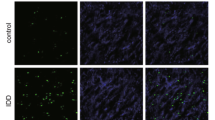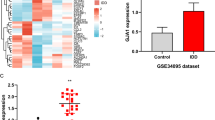Abstract
Intervertebral disc degeneration (IVDD) is considered to be the fundamental cause of the occurrence and development of lumbar disc herniation (LDH). The degeneration of IVDD is mainly caused by the participation of inflammatory factors. Thus, it is of great significance to analyze the pathogenesis of IVDD, which may guide clinical prevention and treatment of LDH. Our current study aims to identify the role of miR-495-3p in LDH and to further unravel the underlying mechanisms. Results in the current study showed that TNF-α treatment markedly inhibited cell viability of HNPC, increased the IL-1β level, and decreased the mRNA level of miR-495-3p in HNPC in a time-dependent manner. Up-regulation of miR-495-3p promoted cell proliferation and inhibited inflammation and apoptosis in TNF-α-induced HNPCs. To investigate the underlying molecular mechanism through which miR-495-3p regulates TNF-α-induced inflammation and apoptosis in HNPCs, we explored the possible target gene of miR-495-3p. Bioinformatics analysis indicated that IL5RA, which is an important gene for TNF-α-induced HNPC injury, was also a target gene of miR-495-3p. A luciferase reporter assay was applied to test and verify the direct target association between miR-495-3p and IL5RA. The results discovered that down-regulation of miR-495-3p markedly reversed the anti-apoptosis and anti-inflammation of sh-IL5RA. In short, the present study evaluated the roles of miR-495-3p and IL5RA in IVDD development and progression. All the data indicated that miRNA-495-3p may play a protective role via inhibiting inflammation and apoptosis in human nucleus pulposus cells by targeting IL5RA pathway. Therefore, miRNA-495-3p may be a potential agent for LDH, and our study may provide a novel strategy in LDH treatment.






Similar content being viewed by others
Availability of Data and Materials
The analyzed data sets generated during the present study are available from the corresponding author on reasonable request.
References
Sedighi, M., and A. Haghnegahdar. 2014. Role of vitamin D3 in treatment of lumbar disc herniation--pain and sensory aspects: Study protocol for a randomized controlled trial. Trials 15: 373.
Kido, T., K. Okuyama, M. Chiba, H. Sasaki, N. Seki, K. Kamo, N. Miyakoshi, and Y. Shimada. 2016. Clinical diagnosis of upper lumbar disc herniation: Pain and/or numbness distribution are more useful for appropriate level diagnosis. Journal of Orthopaedic Science: Official Journal of the Japanese Orthopaedic Association 21: 419–424.
Rainville, J., and E. Lopez. 2013. Comparison of radicular symptoms caused by lumbar disc herniation and lumbar spinal stenosis in the elderly. Spine 38: 1282–1287.
Li, X., Z. Hu, J. Cui, Y. Han, J. Pan, M. Yang, J. Tan, G. Sun, and L. Li. 2016. Percutaneous endoscopic lumbar discectomy for recurrent lumbar disc herniation. International Journal of Surgery 27: 8–16.
Li, W., Y.C. Liu, C.F. Zheng, J. Miao, H. Chen, H.Y. Quan, S.H. Yan, and K. Zhang. 2018. Diagnosis of compressed nerve root in lumbar disc herniation patients by surface electromyography. Orthopaedic Surgery 10: 47–55.
Xiao, L., M. Ding, A. Fernandez, P. Zhao, L. Jin, and X. Li. 2017. Curcumin alleviates lumbar radiculopathy by reducing neuroinflammation, oxidative stress and nociceptive factors. European Cells & Materials 33: 279–293.
Zhao, H., X. Yu, X.S. Tang, F. He, Y.D. Yang, Y. Xiong, Z.G. Hu, and L. Xu. 2017. Relationship between inflammatory cytokines of IL-1β and TNF-α and intervertebral disc degeneration. Zhongguo gu shang = China Journal of Orthopaedics and Traumatology 30: 866–871.
Fei, M., S. Bhatia, T.B. Oriss, M. Yarlagadda, A. Khare, S. Akira, S. Saijo, Y. Iwakura, B.A. Fallert Junecko, T.A. Reinhart, O. Foreman, P. Ray, J. Kolls, and A. Ray. 2011. TNF-alpha from inflammatory dendritic cells (DCs) regulates lung IL-17A/IL-5 levels and neutrophilia versus eosinophilia during persistent fungal infection. Proceedings of the National Academy of Sciences of the United States of America 108: 5360–5365.
Liu, X.Q., A.D. Paterson, N. He, P. St George-Hyslop, V. Rauta, C. Gronhagen-Riska, M. Laakso, L. Thibaudin, F. Berthoux, D. Cattran, and Y. Pei. 2008. IL5RA and TNFRSF6B gene variants are associated with sporadic IgA nephropathy. Journal of the American Society of Nephrology 19: 1025–1033.
McGuire, A., J.A. Brown, and M.J. Kerin. 2015. Metastatic breast cancer: The potential of miRNA for diagnosis and treatment monitoring. Cancer Metastasis Reviews 34: 145–155.
Hayashi, K., S.M. Chuva de Sousa Lopes, M. Kaneda, F. Tang, P. Hajkova, K. Lao, D. O'Carroll, P.P. Das, A. Tarakhovsky, E.A. Miska, and M.A. Surani. 2008. MicroRNA biogenesis is required for mouse primordial germ cell development and spermatogenesis. PLoS One 3: e1738.
Moen, A., D. Jacobsen, S. Phuyal, A. Legfeldt, F. Haugen, C. Røe, and J. Gjerstad. 2017. MicroRNA-223 demonstrated experimentally in exosome-like vesicles is associated with decreased risk of persistent pain after lumbar disc herniation. Journal of Translational Medicine 15: 89.
Lv, F., Y. Huang, W. Lv, L. Yang, F. Li, J. Fan, and J. Sun. 2017. MicroRNA-146a ameliorates inflammation via TRAF6/NF-κB pathway in intervertebral disc cells. Medical Science Monitor : International mEdical Journal of Experimental and Clinical Research 23: 659–664.
Eun, J.W., H.S. Kim, Q. Shen, H.D. Yang, S.Y. Kim, J.H. Yoon, W.S. Park, J.Y. Lee, and S.W. Nam. 2018. MicroRNA-495-3p functions as a tumor suppressor by regulating multiple epigenetic modifiers in gastric carcinogenesis. The Journal of Pathology 244: 107–119.
Ma, D., Y. Liang, D. Wang, Z. Liu, W. Zhang, T. Ma, L. Zhang, X. Lu, and Z. Cai. 2013. Trend of the incidence of lumbar disc herniation: Decreasing with aging in the elderly. Clinical Interventions in Aging 8: 1047–1050.
Abi-Hanna, D., J. Kerferd, K. Phan, P. Rao, and R. Mobbs. 2018. Lumbar disk arthroplasty for degenerative disk disease: Literature review. World Neurosurgery 109: 188–196.
Johnson, Z.I., Z.R. Schoepflin, H. Choi, I.M. Shapiro, and M.V. Risbud. 2015. Disc in flames: Roles of TNF-α and IL-1β in intervertebral disc degeneration. European Cells & Materials 30: 104–116 discussion 116-117.
Xu, F., F. Gao, Y. Liu, Z. Wang, X. Zhuang, Z. Qu, H. Ma, Y. Liu, C. Fu, Q. Zhang, and X. Duan. 2016. Bioinformatics analysis of molecular mechanisms involved in intervertebral disc degeneration induced by TNF-α and IL-1β. Molecular Medicine Reports 13: 2925–2931.
Li, Z., X. Yu, J. Shen, M.T. Chan, and W.K. Wu. 2015. MicroRNA in intervertebral disc degeneration. Cell Proliferation 48: 278–283.
Wang, J., M. Haubrock, K.M. Cao, X. Hua, C.Y. Zhang, E. Wingender, and J. Li. 2011. Regulatory coordination of clustered microRNAs based on microRNA-transcription factor regulatory network. BMC Systems Biology 5: 199.
Author information
Authors and Affiliations
Corresponding author
Ethics declarations
Conflict of Interest
The authors declare that they have no conflict of interest.
Additional information
Publisher’s Note
Springer Nature remains neutral with regard to jurisdictional claims in published maps and institutional affiliations.
Rights and permissions
About this article
Cite this article
Lin, X., Lin, Q. MiRNA-495-3p Attenuates TNF-α Induced Apoptosis and Inflammation in Human Nucleus Pulposus Cells by Targeting IL5RA. Inflammation 43, 1797–1805 (2020). https://doi.org/10.1007/s10753-020-01254-5
Published:
Issue Date:
DOI: https://doi.org/10.1007/s10753-020-01254-5




